Business Law and Employment Practices
VerifiedAdded on 2020/10/22
|12
|3760
|67
AI Summary
This assignment provides an overview of business law in the UK, focusing on employment practices and the importance of employment law for individuals. It discusses how businesses manage their regular affairs and the role of the legal system in regulating public activities. The assignment highlights key concepts and references relevant literature to support its findings.
Contribute Materials
Your contribution can guide someone’s learning journey. Share your
documents today.
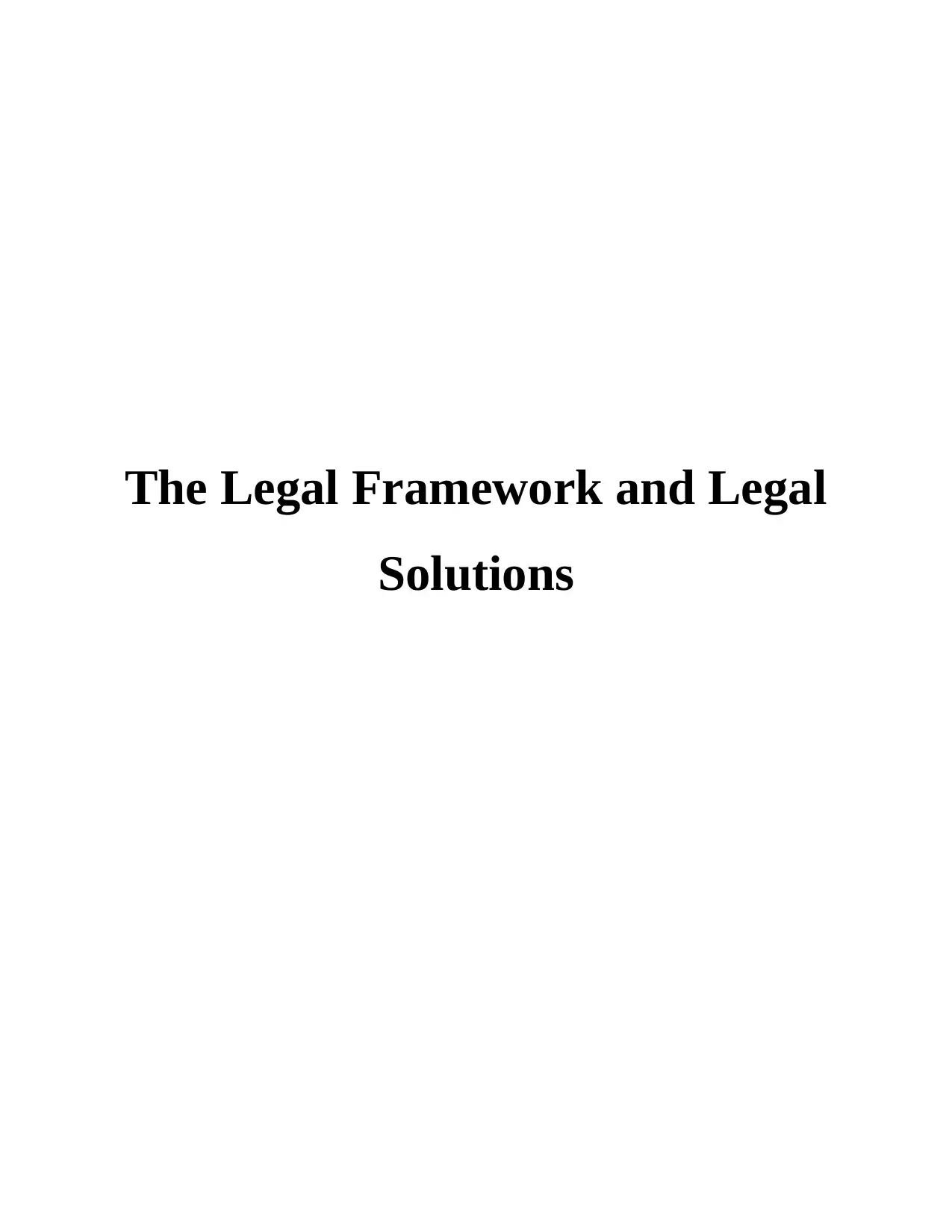
The Legal Framework and Legal
Solutions
Solutions
Secure Best Marks with AI Grader
Need help grading? Try our AI Grader for instant feedback on your assignments.
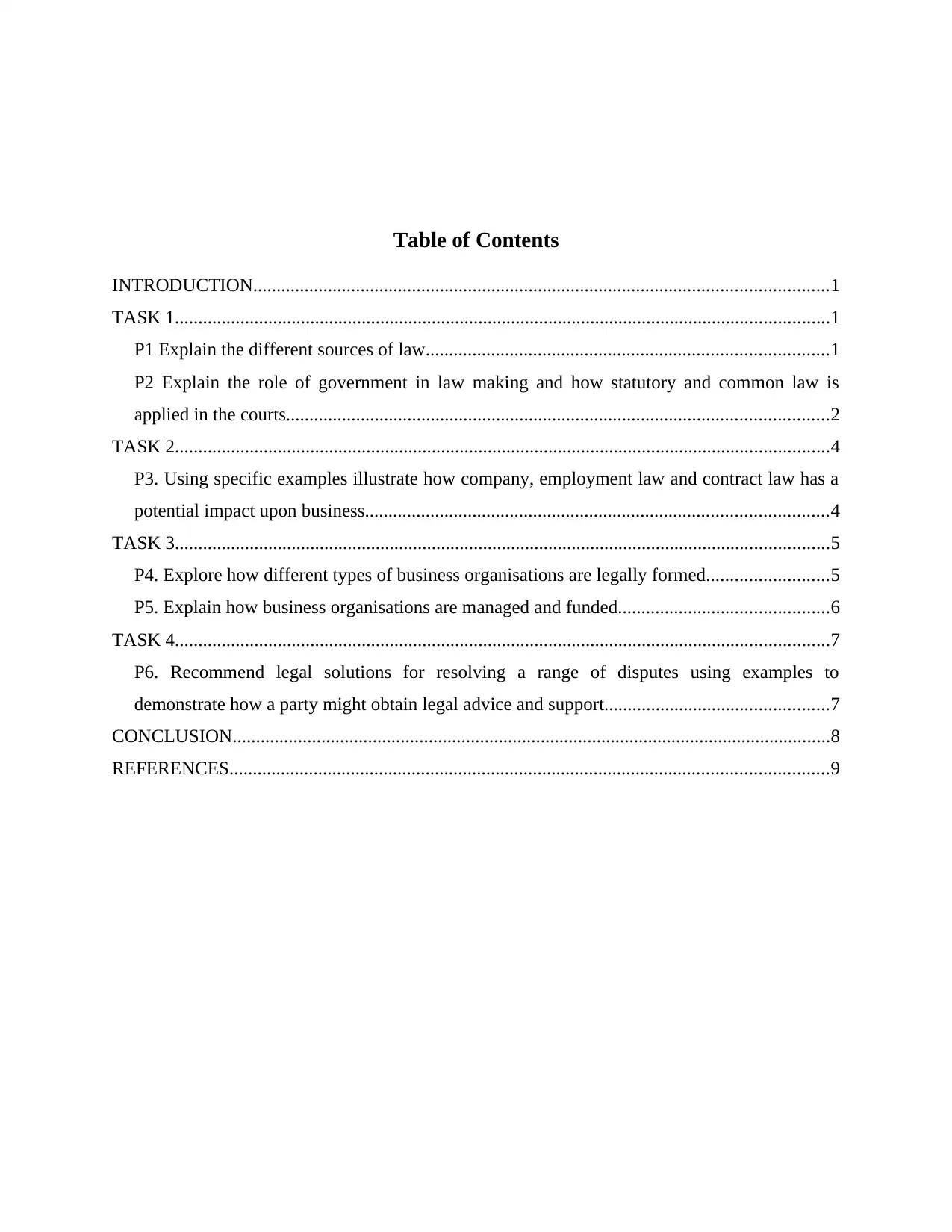
Table of Contents
INTRODUCTION...........................................................................................................................1
TASK 1............................................................................................................................................1
P1 Explain the different sources of law......................................................................................1
P2 Explain the role of government in law making and how statutory and common law is
applied in the courts....................................................................................................................2
TASK 2............................................................................................................................................4
P3. Using specific examples illustrate how company, employment law and contract law has a
potential impact upon business...................................................................................................4
TASK 3............................................................................................................................................5
P4. Explore how different types of business organisations are legally formed..........................5
P5. Explain how business organisations are managed and funded.............................................6
TASK 4............................................................................................................................................7
P6. Recommend legal solutions for resolving a range of disputes using examples to
demonstrate how a party might obtain legal advice and support................................................7
CONCLUSION................................................................................................................................8
REFERENCES................................................................................................................................9
INTRODUCTION...........................................................................................................................1
TASK 1............................................................................................................................................1
P1 Explain the different sources of law......................................................................................1
P2 Explain the role of government in law making and how statutory and common law is
applied in the courts....................................................................................................................2
TASK 2............................................................................................................................................4
P3. Using specific examples illustrate how company, employment law and contract law has a
potential impact upon business...................................................................................................4
TASK 3............................................................................................................................................5
P4. Explore how different types of business organisations are legally formed..........................5
P5. Explain how business organisations are managed and funded.............................................6
TASK 4............................................................................................................................................7
P6. Recommend legal solutions for resolving a range of disputes using examples to
demonstrate how a party might obtain legal advice and support................................................7
CONCLUSION................................................................................................................................8
REFERENCES................................................................................................................................9

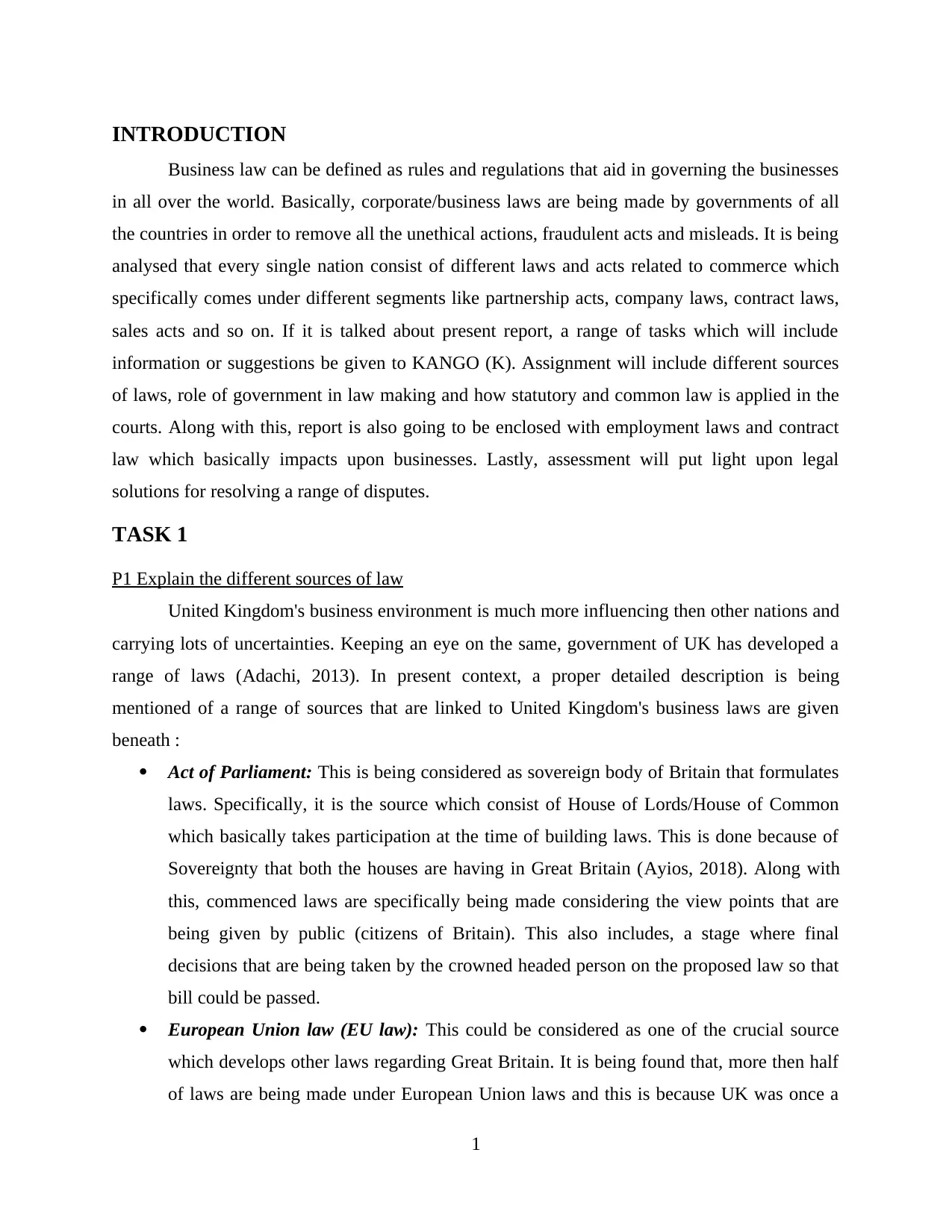
INTRODUCTION
Business law can be defined as rules and regulations that aid in governing the businesses
in all over the world. Basically, corporate/business laws are being made by governments of all
the countries in order to remove all the unethical actions, fraudulent acts and misleads. It is being
analysed that every single nation consist of different laws and acts related to commerce which
specifically comes under different segments like partnership acts, company laws, contract laws,
sales acts and so on. If it is talked about present report, a range of tasks which will include
information or suggestions be given to KANGO (K). Assignment will include different sources
of laws, role of government in law making and how statutory and common law is applied in the
courts. Along with this, report is also going to be enclosed with employment laws and contract
law which basically impacts upon businesses. Lastly, assessment will put light upon legal
solutions for resolving a range of disputes.
TASK 1
P1 Explain the different sources of law
United Kingdom's business environment is much more influencing then other nations and
carrying lots of uncertainties. Keeping an eye on the same, government of UK has developed a
range of laws (Adachi, 2013). In present context, a proper detailed description is being
mentioned of a range of sources that are linked to United Kingdom's business laws are given
beneath :
Act of Parliament: This is being considered as sovereign body of Britain that formulates
laws. Specifically, it is the source which consist of House of Lords/House of Common
which basically takes participation at the time of building laws. This is done because of
Sovereignty that both the houses are having in Great Britain (Ayios, 2018). Along with
this, commenced laws are specifically being made considering the view points that are
being given by public (citizens of Britain). This also includes, a stage where final
decisions that are being taken by the crowned headed person on the proposed law so that
bill could be passed.
European Union law (EU law): This could be considered as one of the crucial source
which develops other laws regarding Great Britain. It is being found that, more then half
of laws are being made under European Union laws and this is because UK was once a
1
Business law can be defined as rules and regulations that aid in governing the businesses
in all over the world. Basically, corporate/business laws are being made by governments of all
the countries in order to remove all the unethical actions, fraudulent acts and misleads. It is being
analysed that every single nation consist of different laws and acts related to commerce which
specifically comes under different segments like partnership acts, company laws, contract laws,
sales acts and so on. If it is talked about present report, a range of tasks which will include
information or suggestions be given to KANGO (K). Assignment will include different sources
of laws, role of government in law making and how statutory and common law is applied in the
courts. Along with this, report is also going to be enclosed with employment laws and contract
law which basically impacts upon businesses. Lastly, assessment will put light upon legal
solutions for resolving a range of disputes.
TASK 1
P1 Explain the different sources of law
United Kingdom's business environment is much more influencing then other nations and
carrying lots of uncertainties. Keeping an eye on the same, government of UK has developed a
range of laws (Adachi, 2013). In present context, a proper detailed description is being
mentioned of a range of sources that are linked to United Kingdom's business laws are given
beneath :
Act of Parliament: This is being considered as sovereign body of Britain that formulates
laws. Specifically, it is the source which consist of House of Lords/House of Common
which basically takes participation at the time of building laws. This is done because of
Sovereignty that both the houses are having in Great Britain (Ayios, 2018). Along with
this, commenced laws are specifically being made considering the view points that are
being given by public (citizens of Britain). This also includes, a stage where final
decisions that are being taken by the crowned headed person on the proposed law so that
bill could be passed.
European Union law (EU law): This could be considered as one of the crucial source
which develops other laws regarding Great Britain. It is being found that, more then half
of laws are being made under European Union laws and this is because UK was once a
1
Secure Best Marks with AI Grader
Need help grading? Try our AI Grader for instant feedback on your assignments.
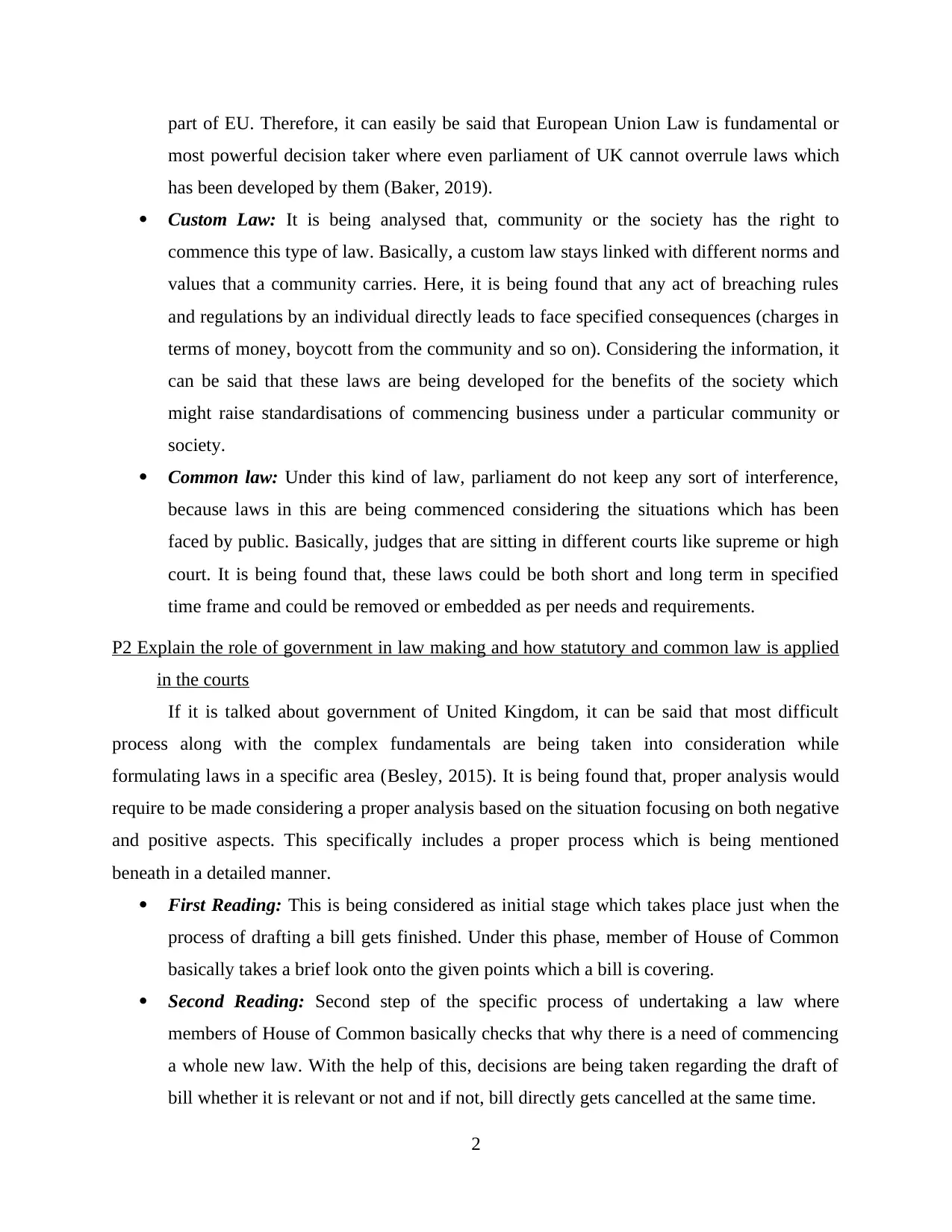
part of EU. Therefore, it can easily be said that European Union Law is fundamental or
most powerful decision taker where even parliament of UK cannot overrule laws which
has been developed by them (Baker, 2019).
Custom Law: It is being analysed that, community or the society has the right to
commence this type of law. Basically, a custom law stays linked with different norms and
values that a community carries. Here, it is being found that any act of breaching rules
and regulations by an individual directly leads to face specified consequences (charges in
terms of money, boycott from the community and so on). Considering the information, it
can be said that these laws are being developed for the benefits of the society which
might raise standardisations of commencing business under a particular community or
society.
Common law: Under this kind of law, parliament do not keep any sort of interference,
because laws in this are being commenced considering the situations which has been
faced by public. Basically, judges that are sitting in different courts like supreme or high
court. It is being found that, these laws could be both short and long term in specified
time frame and could be removed or embedded as per needs and requirements.
P2 Explain the role of government in law making and how statutory and common law is applied
in the courts
If it is talked about government of United Kingdom, it can be said that most difficult
process along with the complex fundamentals are being taken into consideration while
formulating laws in a specific area (Besley, 2015). It is being found that, proper analysis would
require to be made considering a proper analysis based on the situation focusing on both negative
and positive aspects. This specifically includes a proper process which is being mentioned
beneath in a detailed manner.
First Reading: This is being considered as initial stage which takes place just when the
process of drafting a bill gets finished. Under this phase, member of House of Common
basically takes a brief look onto the given points which a bill is covering.
Second Reading: Second step of the specific process of undertaking a law where
members of House of Common basically checks that why there is a need of commencing
a whole new law. With the help of this, decisions are being taken regarding the draft of
bill whether it is relevant or not and if not, bill directly gets cancelled at the same time.
2
most powerful decision taker where even parliament of UK cannot overrule laws which
has been developed by them (Baker, 2019).
Custom Law: It is being analysed that, community or the society has the right to
commence this type of law. Basically, a custom law stays linked with different norms and
values that a community carries. Here, it is being found that any act of breaching rules
and regulations by an individual directly leads to face specified consequences (charges in
terms of money, boycott from the community and so on). Considering the information, it
can be said that these laws are being developed for the benefits of the society which
might raise standardisations of commencing business under a particular community or
society.
Common law: Under this kind of law, parliament do not keep any sort of interference,
because laws in this are being commenced considering the situations which has been
faced by public. Basically, judges that are sitting in different courts like supreme or high
court. It is being found that, these laws could be both short and long term in specified
time frame and could be removed or embedded as per needs and requirements.
P2 Explain the role of government in law making and how statutory and common law is applied
in the courts
If it is talked about government of United Kingdom, it can be said that most difficult
process along with the complex fundamentals are being taken into consideration while
formulating laws in a specific area (Besley, 2015). It is being found that, proper analysis would
require to be made considering a proper analysis based on the situation focusing on both negative
and positive aspects. This specifically includes a proper process which is being mentioned
beneath in a detailed manner.
First Reading: This is being considered as initial stage which takes place just when the
process of drafting a bill gets finished. Under this phase, member of House of Common
basically takes a brief look onto the given points which a bill is covering.
Second Reading: Second step of the specific process of undertaking a law where
members of House of Common basically checks that why there is a need of commencing
a whole new law. With the help of this, decisions are being taken regarding the draft of
bill whether it is relevant or not and if not, bill directly gets cancelled at the same time.
2
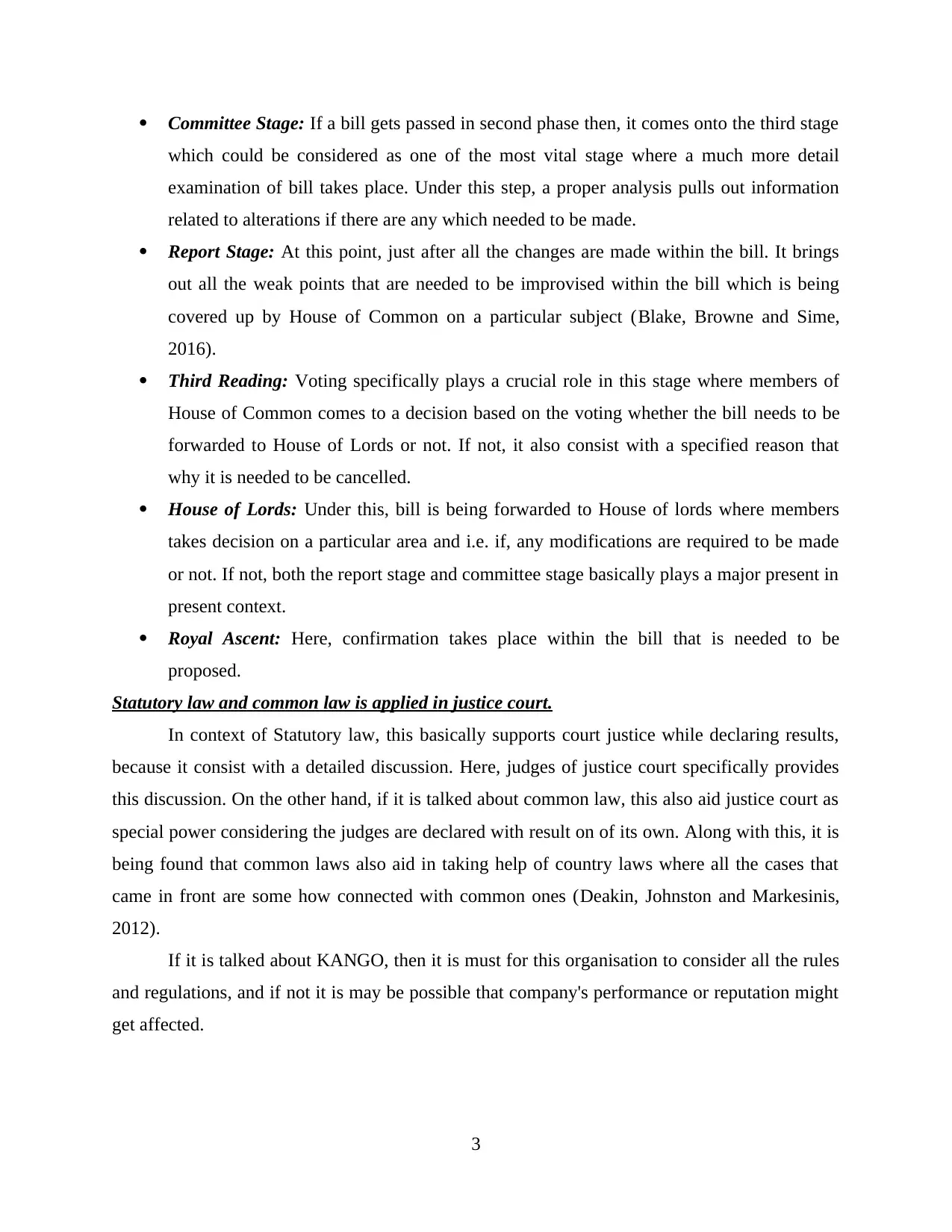
Committee Stage: If a bill gets passed in second phase then, it comes onto the third stage
which could be considered as one of the most vital stage where a much more detail
examination of bill takes place. Under this step, a proper analysis pulls out information
related to alterations if there are any which needed to be made.
Report Stage: At this point, just after all the changes are made within the bill. It brings
out all the weak points that are needed to be improvised within the bill which is being
covered up by House of Common on a particular subject (Blake, Browne and Sime,
2016).
Third Reading: Voting specifically plays a crucial role in this stage where members of
House of Common comes to a decision based on the voting whether the bill needs to be
forwarded to House of Lords or not. If not, it also consist with a specified reason that
why it is needed to be cancelled.
House of Lords: Under this, bill is being forwarded to House of lords where members
takes decision on a particular area and i.e. if, any modifications are required to be made
or not. If not, both the report stage and committee stage basically plays a major present in
present context.
Royal Ascent: Here, confirmation takes place within the bill that is needed to be
proposed.
Statutory law and common law is applied in justice court.
In context of Statutory law, this basically supports court justice while declaring results,
because it consist with a detailed discussion. Here, judges of justice court specifically provides
this discussion. On the other hand, if it is talked about common law, this also aid justice court as
special power considering the judges are declared with result on of its own. Along with this, it is
being found that common laws also aid in taking help of country laws where all the cases that
came in front are some how connected with common ones (Deakin, Johnston and Markesinis,
2012).
If it is talked about KANGO, then it is must for this organisation to consider all the rules
and regulations, and if not it is may be possible that company's performance or reputation might
get affected.
3
which could be considered as one of the most vital stage where a much more detail
examination of bill takes place. Under this step, a proper analysis pulls out information
related to alterations if there are any which needed to be made.
Report Stage: At this point, just after all the changes are made within the bill. It brings
out all the weak points that are needed to be improvised within the bill which is being
covered up by House of Common on a particular subject (Blake, Browne and Sime,
2016).
Third Reading: Voting specifically plays a crucial role in this stage where members of
House of Common comes to a decision based on the voting whether the bill needs to be
forwarded to House of Lords or not. If not, it also consist with a specified reason that
why it is needed to be cancelled.
House of Lords: Under this, bill is being forwarded to House of lords where members
takes decision on a particular area and i.e. if, any modifications are required to be made
or not. If not, both the report stage and committee stage basically plays a major present in
present context.
Royal Ascent: Here, confirmation takes place within the bill that is needed to be
proposed.
Statutory law and common law is applied in justice court.
In context of Statutory law, this basically supports court justice while declaring results,
because it consist with a detailed discussion. Here, judges of justice court specifically provides
this discussion. On the other hand, if it is talked about common law, this also aid justice court as
special power considering the judges are declared with result on of its own. Along with this, it is
being found that common laws also aid in taking help of country laws where all the cases that
came in front are some how connected with common ones (Deakin, Johnston and Markesinis,
2012).
If it is talked about KANGO, then it is must for this organisation to consider all the rules
and regulations, and if not it is may be possible that company's performance or reputation might
get affected.
3
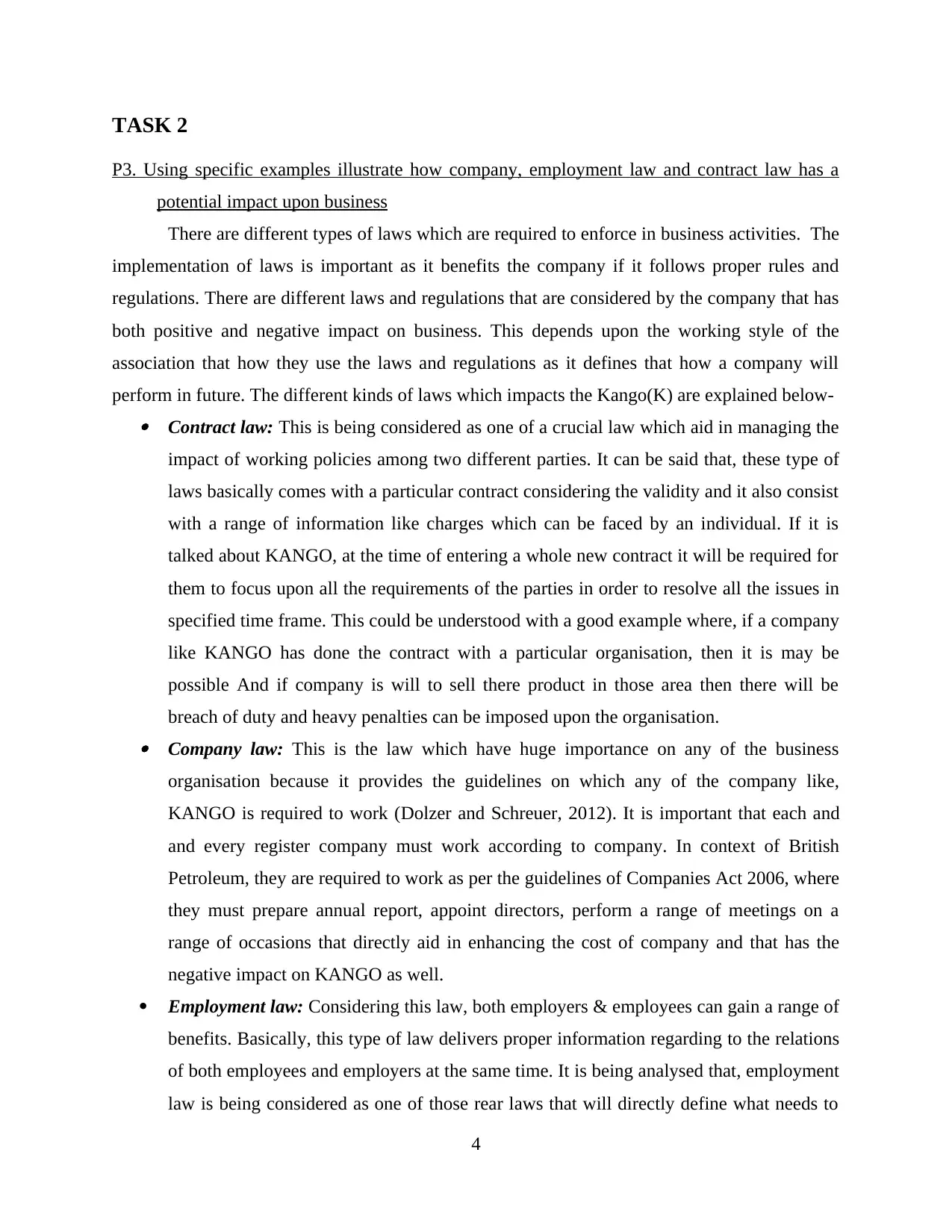
TASK 2
P3. Using specific examples illustrate how company, employment law and contract law has a
potential impact upon business
There are different types of laws which are required to enforce in business activities. The
implementation of laws is important as it benefits the company if it follows proper rules and
regulations. There are different laws and regulations that are considered by the company that has
both positive and negative impact on business. This depends upon the working style of the
association that how they use the laws and regulations as it defines that how a company will
perform in future. The different kinds of laws which impacts the Kango(K) are explained below- Contract law: This is being considered as one of a crucial law which aid in managing the
impact of working policies among two different parties. It can be said that, these type of
laws basically comes with a particular contract considering the validity and it also consist
with a range of information like charges which can be faced by an individual. If it is
talked about KANGO, at the time of entering a whole new contract it will be required for
them to focus upon all the requirements of the parties in order to resolve all the issues in
specified time frame. This could be understood with a good example where, if a company
like KANGO has done the contract with a particular organisation, then it is may be
possible And if company is will to sell there product in those area then there will be
breach of duty and heavy penalties can be imposed upon the organisation. Company law: This is the law which have huge importance on any of the business
organisation because it provides the guidelines on which any of the company like,
KANGO is required to work (Dolzer and Schreuer, 2012). It is important that each and
and every register company must work according to company. In context of British
Petroleum, they are required to work as per the guidelines of Companies Act 2006, where
they must prepare annual report, appoint directors, perform a range of meetings on a
range of occasions that directly aid in enhancing the cost of company and that has the
negative impact on KANGO as well.
Employment law: Considering this law, both employers & employees can gain a range of
benefits. Basically, this type of law delivers proper information regarding to the relations
of both employees and employers at the same time. It is being analysed that, employment
law is being considered as one of those rear laws that will directly define what needs to
4
P3. Using specific examples illustrate how company, employment law and contract law has a
potential impact upon business
There are different types of laws which are required to enforce in business activities. The
implementation of laws is important as it benefits the company if it follows proper rules and
regulations. There are different laws and regulations that are considered by the company that has
both positive and negative impact on business. This depends upon the working style of the
association that how they use the laws and regulations as it defines that how a company will
perform in future. The different kinds of laws which impacts the Kango(K) are explained below- Contract law: This is being considered as one of a crucial law which aid in managing the
impact of working policies among two different parties. It can be said that, these type of
laws basically comes with a particular contract considering the validity and it also consist
with a range of information like charges which can be faced by an individual. If it is
talked about KANGO, at the time of entering a whole new contract it will be required for
them to focus upon all the requirements of the parties in order to resolve all the issues in
specified time frame. This could be understood with a good example where, if a company
like KANGO has done the contract with a particular organisation, then it is may be
possible And if company is will to sell there product in those area then there will be
breach of duty and heavy penalties can be imposed upon the organisation. Company law: This is the law which have huge importance on any of the business
organisation because it provides the guidelines on which any of the company like,
KANGO is required to work (Dolzer and Schreuer, 2012). It is important that each and
and every register company must work according to company. In context of British
Petroleum, they are required to work as per the guidelines of Companies Act 2006, where
they must prepare annual report, appoint directors, perform a range of meetings on a
range of occasions that directly aid in enhancing the cost of company and that has the
negative impact on KANGO as well.
Employment law: Considering this law, both employers & employees can gain a range of
benefits. Basically, this type of law delivers proper information regarding to the relations
of both employees and employers at the same time. It is being analysed that, employment
law is being considered as one of those rear laws that will directly define what needs to
4
Paraphrase This Document
Need a fresh take? Get an instant paraphrase of this document with our AI Paraphraser
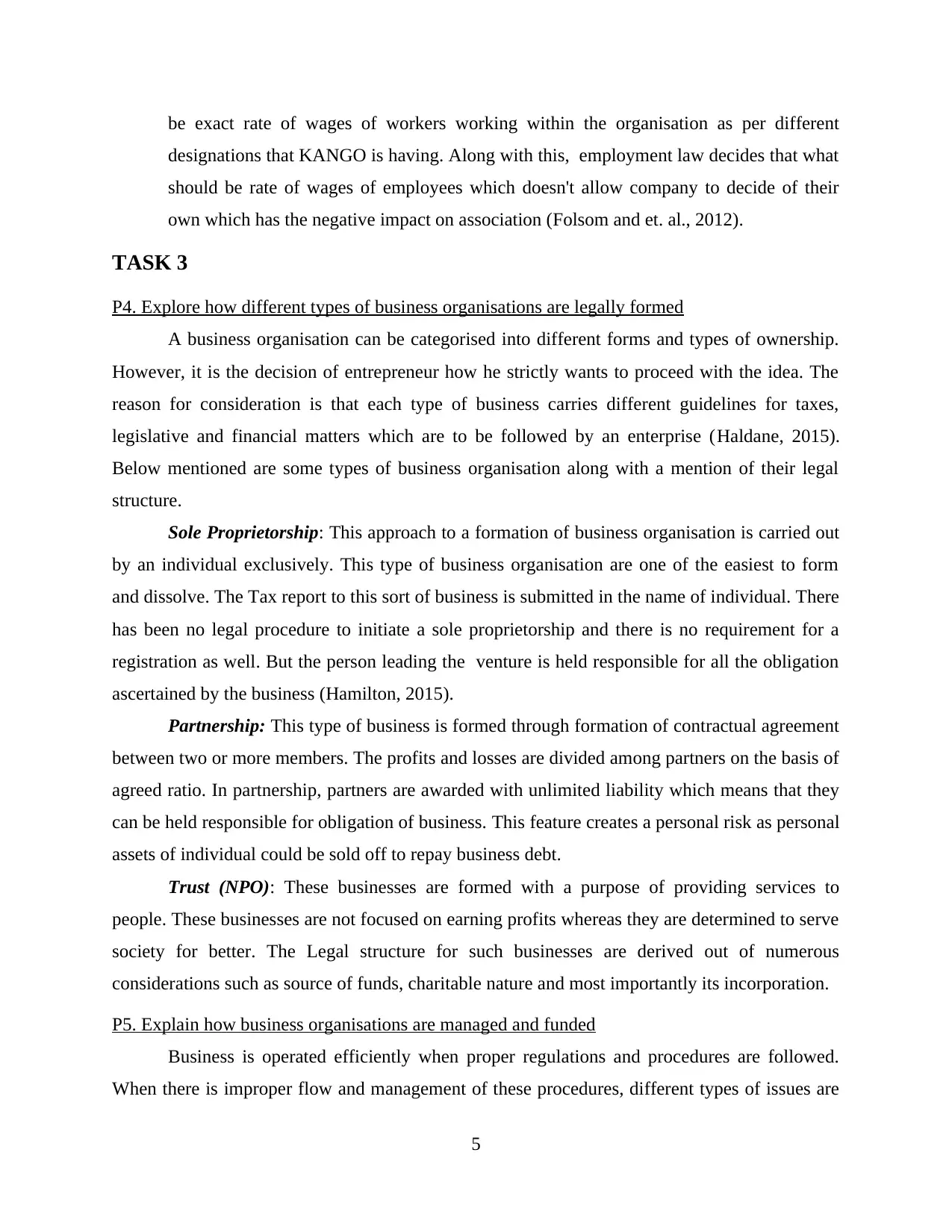
be exact rate of wages of workers working within the organisation as per different
designations that KANGO is having. Along with this, employment law decides that what
should be rate of wages of employees which doesn't allow company to decide of their
own which has the negative impact on association (Folsom and et. al., 2012).
TASK 3
P4. Explore how different types of business organisations are legally formed
A business organisation can be categorised into different forms and types of ownership.
However, it is the decision of entrepreneur how he strictly wants to proceed with the idea. The
reason for consideration is that each type of business carries different guidelines for taxes,
legislative and financial matters which are to be followed by an enterprise (Haldane, 2015).
Below mentioned are some types of business organisation along with a mention of their legal
structure.
Sole Proprietorship: This approach to a formation of business organisation is carried out
by an individual exclusively. This type of business organisation are one of the easiest to form
and dissolve. The Tax report to this sort of business is submitted in the name of individual. There
has been no legal procedure to initiate a sole proprietorship and there is no requirement for a
registration as well. But the person leading the venture is held responsible for all the obligation
ascertained by the business (Hamilton, 2015).
Partnership: This type of business is formed through formation of contractual agreement
between two or more members. The profits and losses are divided among partners on the basis of
agreed ratio. In partnership, partners are awarded with unlimited liability which means that they
can be held responsible for obligation of business. This feature creates a personal risk as personal
assets of individual could be sold off to repay business debt.
Trust (NPO): These businesses are formed with a purpose of providing services to
people. These businesses are not focused on earning profits whereas they are determined to serve
society for better. The Legal structure for such businesses are derived out of numerous
considerations such as source of funds, charitable nature and most importantly its incorporation.
P5. Explain how business organisations are managed and funded
Business is operated efficiently when proper regulations and procedures are followed.
When there is improper flow and management of these procedures, different types of issues are
5
designations that KANGO is having. Along with this, employment law decides that what
should be rate of wages of employees which doesn't allow company to decide of their
own which has the negative impact on association (Folsom and et. al., 2012).
TASK 3
P4. Explore how different types of business organisations are legally formed
A business organisation can be categorised into different forms and types of ownership.
However, it is the decision of entrepreneur how he strictly wants to proceed with the idea. The
reason for consideration is that each type of business carries different guidelines for taxes,
legislative and financial matters which are to be followed by an enterprise (Haldane, 2015).
Below mentioned are some types of business organisation along with a mention of their legal
structure.
Sole Proprietorship: This approach to a formation of business organisation is carried out
by an individual exclusively. This type of business organisation are one of the easiest to form
and dissolve. The Tax report to this sort of business is submitted in the name of individual. There
has been no legal procedure to initiate a sole proprietorship and there is no requirement for a
registration as well. But the person leading the venture is held responsible for all the obligation
ascertained by the business (Hamilton, 2015).
Partnership: This type of business is formed through formation of contractual agreement
between two or more members. The profits and losses are divided among partners on the basis of
agreed ratio. In partnership, partners are awarded with unlimited liability which means that they
can be held responsible for obligation of business. This feature creates a personal risk as personal
assets of individual could be sold off to repay business debt.
Trust (NPO): These businesses are formed with a purpose of providing services to
people. These businesses are not focused on earning profits whereas they are determined to serve
society for better. The Legal structure for such businesses are derived out of numerous
considerations such as source of funds, charitable nature and most importantly its incorporation.
P5. Explain how business organisations are managed and funded
Business is operated efficiently when proper regulations and procedures are followed.
When there is improper flow and management of these procedures, different types of issues are
5
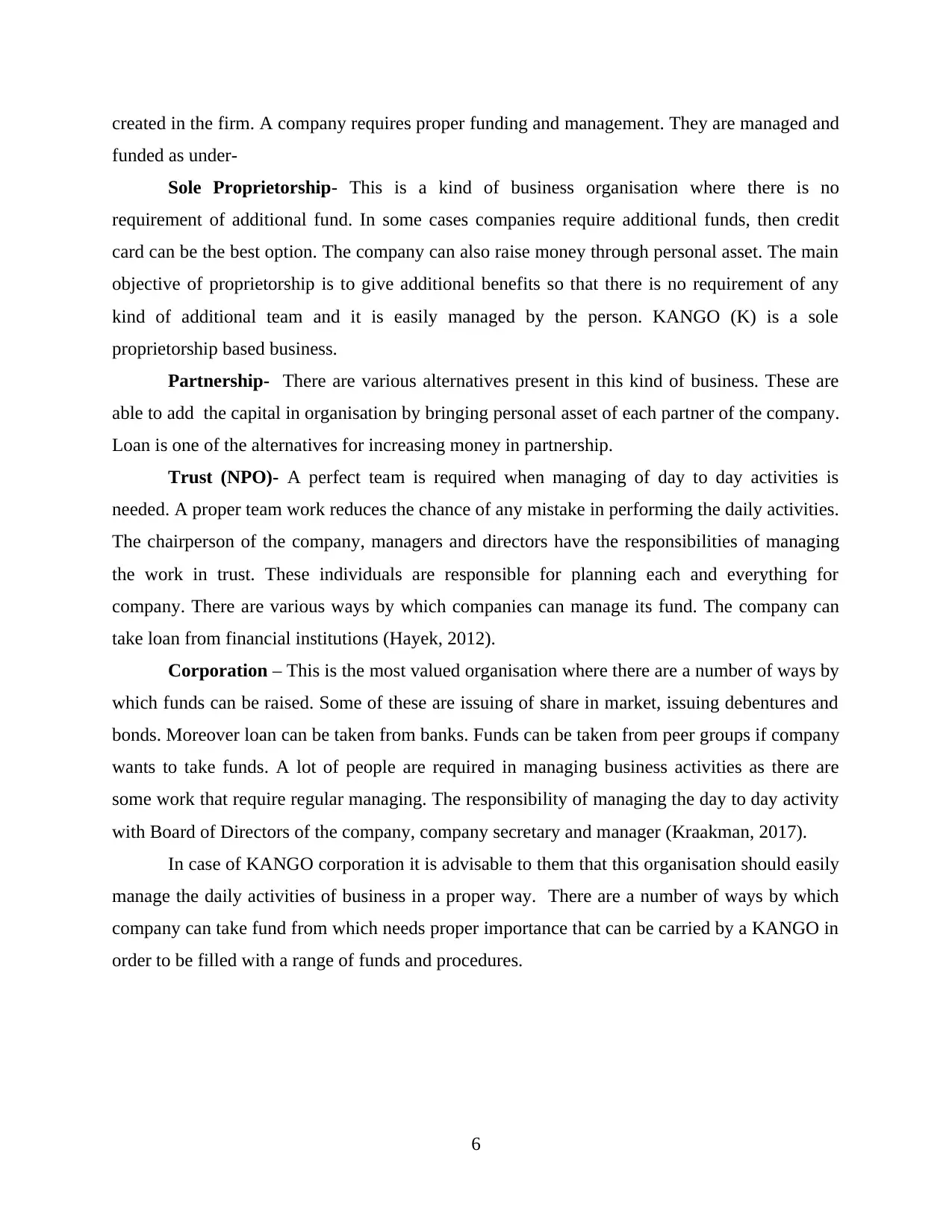
created in the firm. A company requires proper funding and management. They are managed and
funded as under-
Sole Proprietorship- This is a kind of business organisation where there is no
requirement of additional fund. In some cases companies require additional funds, then credit
card can be the best option. The company can also raise money through personal asset. The main
objective of proprietorship is to give additional benefits so that there is no requirement of any
kind of additional team and it is easily managed by the person. KANGO (K) is a sole
proprietorship based business.
Partnership- There are various alternatives present in this kind of business. These are
able to add the capital in organisation by bringing personal asset of each partner of the company.
Loan is one of the alternatives for increasing money in partnership.
Trust (NPO)- A perfect team is required when managing of day to day activities is
needed. A proper team work reduces the chance of any mistake in performing the daily activities.
The chairperson of the company, managers and directors have the responsibilities of managing
the work in trust. These individuals are responsible for planning each and everything for
company. There are various ways by which companies can manage its fund. The company can
take loan from financial institutions (Hayek, 2012).
Corporation – This is the most valued organisation where there are a number of ways by
which funds can be raised. Some of these are issuing of share in market, issuing debentures and
bonds. Moreover loan can be taken from banks. Funds can be taken from peer groups if company
wants to take funds. A lot of people are required in managing business activities as there are
some work that require regular managing. The responsibility of managing the day to day activity
with Board of Directors of the company, company secretary and manager (Kraakman, 2017).
In case of KANGO corporation it is advisable to them that this organisation should easily
manage the daily activities of business in a proper way. There are a number of ways by which
company can take fund from which needs proper importance that can be carried by a KANGO in
order to be filled with a range of funds and procedures.
6
funded as under-
Sole Proprietorship- This is a kind of business organisation where there is no
requirement of additional fund. In some cases companies require additional funds, then credit
card can be the best option. The company can also raise money through personal asset. The main
objective of proprietorship is to give additional benefits so that there is no requirement of any
kind of additional team and it is easily managed by the person. KANGO (K) is a sole
proprietorship based business.
Partnership- There are various alternatives present in this kind of business. These are
able to add the capital in organisation by bringing personal asset of each partner of the company.
Loan is one of the alternatives for increasing money in partnership.
Trust (NPO)- A perfect team is required when managing of day to day activities is
needed. A proper team work reduces the chance of any mistake in performing the daily activities.
The chairperson of the company, managers and directors have the responsibilities of managing
the work in trust. These individuals are responsible for planning each and everything for
company. There are various ways by which companies can manage its fund. The company can
take loan from financial institutions (Hayek, 2012).
Corporation – This is the most valued organisation where there are a number of ways by
which funds can be raised. Some of these are issuing of share in market, issuing debentures and
bonds. Moreover loan can be taken from banks. Funds can be taken from peer groups if company
wants to take funds. A lot of people are required in managing business activities as there are
some work that require regular managing. The responsibility of managing the day to day activity
with Board of Directors of the company, company secretary and manager (Kraakman, 2017).
In case of KANGO corporation it is advisable to them that this organisation should easily
manage the daily activities of business in a proper way. There are a number of ways by which
company can take fund from which needs proper importance that can be carried by a KANGO in
order to be filled with a range of funds and procedures.
6
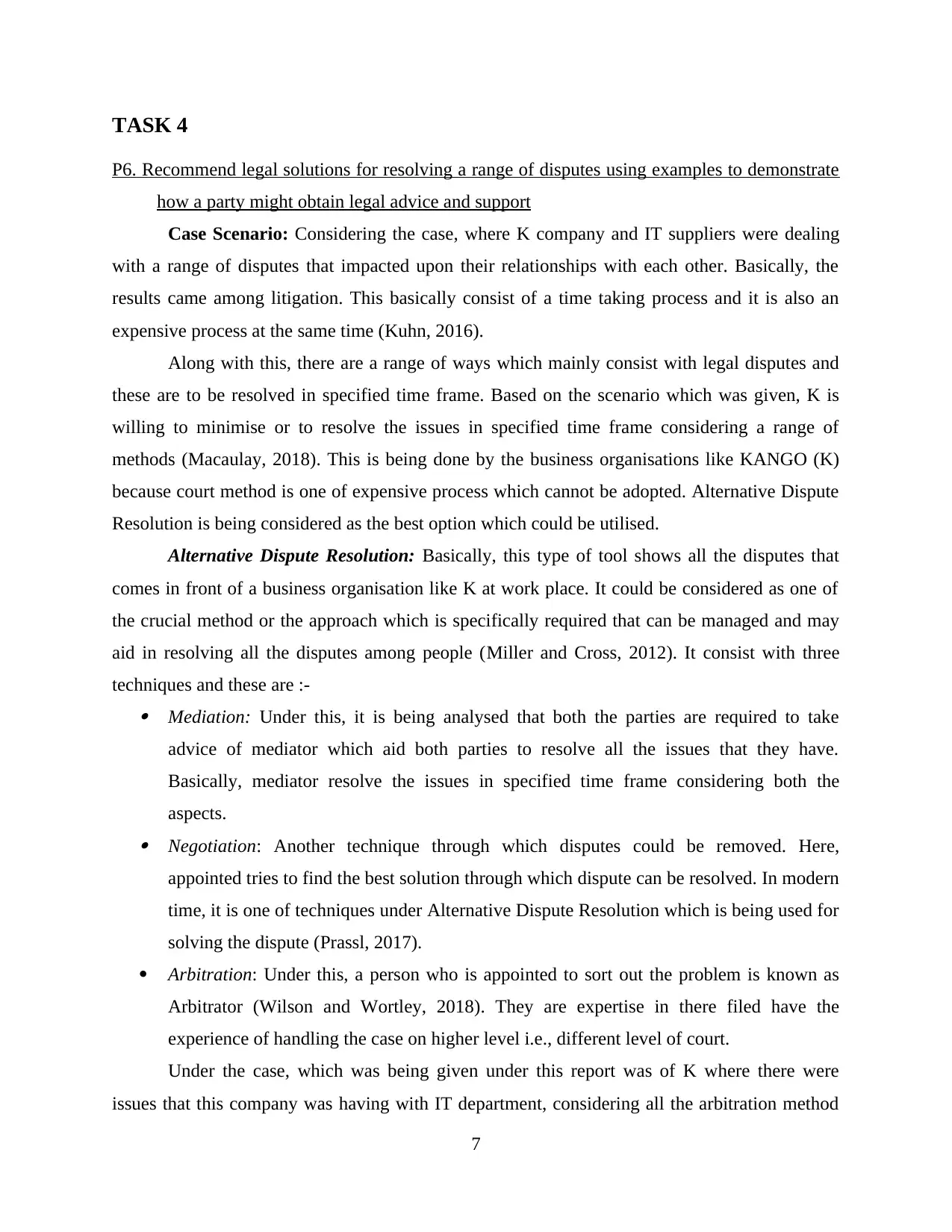
TASK 4
P6. Recommend legal solutions for resolving a range of disputes using examples to demonstrate
how a party might obtain legal advice and support
Case Scenario: Considering the case, where K company and IT suppliers were dealing
with a range of disputes that impacted upon their relationships with each other. Basically, the
results came among litigation. This basically consist of a time taking process and it is also an
expensive process at the same time (Kuhn, 2016).
Along with this, there are a range of ways which mainly consist with legal disputes and
these are to be resolved in specified time frame. Based on the scenario which was given, K is
willing to minimise or to resolve the issues in specified time frame considering a range of
methods (Macaulay, 2018). This is being done by the business organisations like KANGO (K)
because court method is one of expensive process which cannot be adopted. Alternative Dispute
Resolution is being considered as the best option which could be utilised.
Alternative Dispute Resolution: Basically, this type of tool shows all the disputes that
comes in front of a business organisation like K at work place. It could be considered as one of
the crucial method or the approach which is specifically required that can be managed and may
aid in resolving all the disputes among people (Miller and Cross, 2012). It consist with three
techniques and these are :- Mediation: Under this, it is being analysed that both the parties are required to take
advice of mediator which aid both parties to resolve all the issues that they have.
Basically, mediator resolve the issues in specified time frame considering both the
aspects. Negotiation: Another technique through which disputes could be removed. Here,
appointed tries to find the best solution through which dispute can be resolved. In modern
time, it is one of techniques under Alternative Dispute Resolution which is being used for
solving the dispute (Prassl, 2017).
Arbitration: Under this, a person who is appointed to sort out the problem is known as
Arbitrator (Wilson and Wortley, 2018). They are expertise in there filed have the
experience of handling the case on higher level i.e., different level of court.
Under the case, which was being given under this report was of K where there were
issues that this company was having with IT department, considering all the arbitration method
7
P6. Recommend legal solutions for resolving a range of disputes using examples to demonstrate
how a party might obtain legal advice and support
Case Scenario: Considering the case, where K company and IT suppliers were dealing
with a range of disputes that impacted upon their relationships with each other. Basically, the
results came among litigation. This basically consist of a time taking process and it is also an
expensive process at the same time (Kuhn, 2016).
Along with this, there are a range of ways which mainly consist with legal disputes and
these are to be resolved in specified time frame. Based on the scenario which was given, K is
willing to minimise or to resolve the issues in specified time frame considering a range of
methods (Macaulay, 2018). This is being done by the business organisations like KANGO (K)
because court method is one of expensive process which cannot be adopted. Alternative Dispute
Resolution is being considered as the best option which could be utilised.
Alternative Dispute Resolution: Basically, this type of tool shows all the disputes that
comes in front of a business organisation like K at work place. It could be considered as one of
the crucial method or the approach which is specifically required that can be managed and may
aid in resolving all the disputes among people (Miller and Cross, 2012). It consist with three
techniques and these are :- Mediation: Under this, it is being analysed that both the parties are required to take
advice of mediator which aid both parties to resolve all the issues that they have.
Basically, mediator resolve the issues in specified time frame considering both the
aspects. Negotiation: Another technique through which disputes could be removed. Here,
appointed tries to find the best solution through which dispute can be resolved. In modern
time, it is one of techniques under Alternative Dispute Resolution which is being used for
solving the dispute (Prassl, 2017).
Arbitration: Under this, a person who is appointed to sort out the problem is known as
Arbitrator (Wilson and Wortley, 2018). They are expertise in there filed have the
experience of handling the case on higher level i.e., different level of court.
Under the case, which was being given under this report was of K where there were
issues that this company was having with IT department, considering all the arbitration method
7
Secure Best Marks with AI Grader
Need help grading? Try our AI Grader for instant feedback on your assignments.
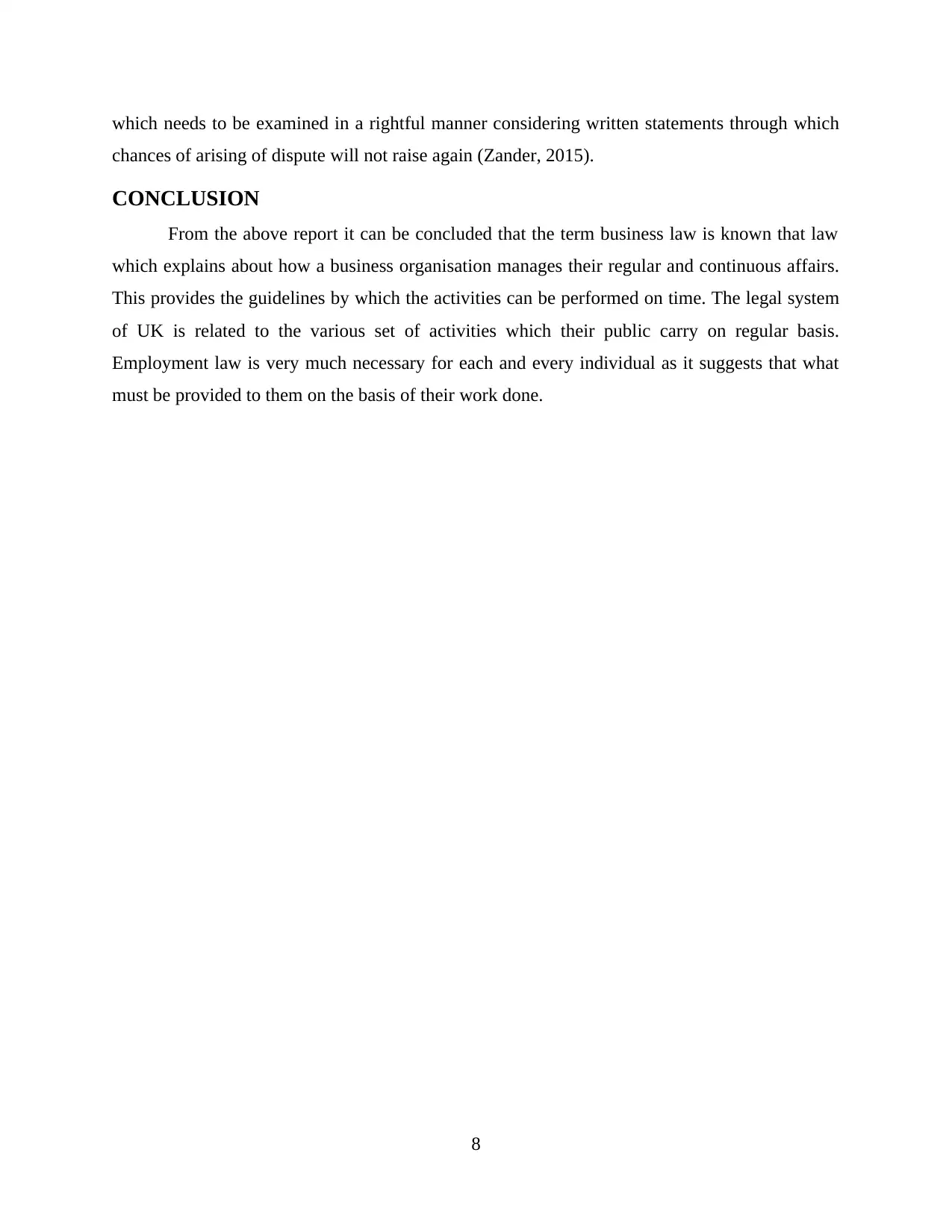
which needs to be examined in a rightful manner considering written statements through which
chances of arising of dispute will not raise again (Zander, 2015).
CONCLUSION
From the above report it can be concluded that the term business law is known that law
which explains about how a business organisation manages their regular and continuous affairs.
This provides the guidelines by which the activities can be performed on time. The legal system
of UK is related to the various set of activities which their public carry on regular basis.
Employment law is very much necessary for each and every individual as it suggests that what
must be provided to them on the basis of their work done.
8
chances of arising of dispute will not raise again (Zander, 2015).
CONCLUSION
From the above report it can be concluded that the term business law is known that law
which explains about how a business organisation manages their regular and continuous affairs.
This provides the guidelines by which the activities can be performed on time. The legal system
of UK is related to the various set of activities which their public carry on regular basis.
Employment law is very much necessary for each and every individual as it suggests that what
must be provided to them on the basis of their work done.
8
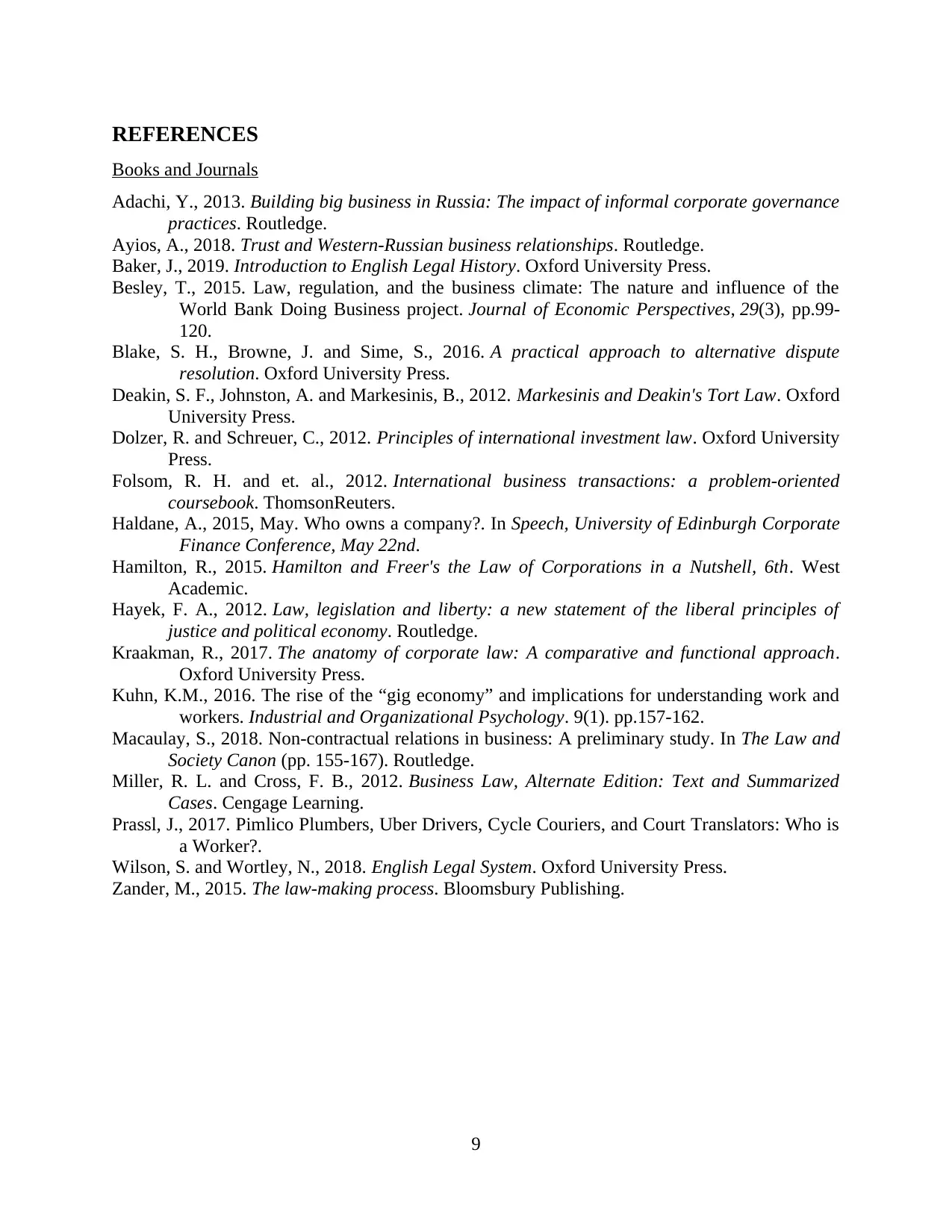
REFERENCES
Books and Journals
Adachi, Y., 2013. Building big business in Russia: The impact of informal corporate governance
practices. Routledge.
Ayios, A., 2018. Trust and Western-Russian business relationships. Routledge.
Baker, J., 2019. Introduction to English Legal History. Oxford University Press.
Besley, T., 2015. Law, regulation, and the business climate: The nature and influence of the
World Bank Doing Business project. Journal of Economic Perspectives, 29(3), pp.99-
120.
Blake, S. H., Browne, J. and Sime, S., 2016. A practical approach to alternative dispute
resolution. Oxford University Press.
Deakin, S. F., Johnston, A. and Markesinis, B., 2012. Markesinis and Deakin's Tort Law. Oxford
University Press.
Dolzer, R. and Schreuer, C., 2012. Principles of international investment law. Oxford University
Press.
Folsom, R. H. and et. al., 2012. International business transactions: a problem-oriented
coursebook. ThomsonReuters.
Haldane, A., 2015, May. Who owns a company?. In Speech, University of Edinburgh Corporate
Finance Conference, May 22nd.
Hamilton, R., 2015. Hamilton and Freer's the Law of Corporations in a Nutshell, 6th. West
Academic.
Hayek, F. A., 2012. Law, legislation and liberty: a new statement of the liberal principles of
justice and political economy. Routledge.
Kraakman, R., 2017. The anatomy of corporate law: A comparative and functional approach.
Oxford University Press.
Kuhn, K.M., 2016. The rise of the “gig economy” and implications for understanding work and
workers. Industrial and Organizational Psychology. 9(1). pp.157-162.
Macaulay, S., 2018. Non-contractual relations in business: A preliminary study. In The Law and
Society Canon (pp. 155-167). Routledge.
Miller, R. L. and Cross, F. B., 2012. Business Law, Alternate Edition: Text and Summarized
Cases. Cengage Learning.
Prassl, J., 2017. Pimlico Plumbers, Uber Drivers, Cycle Couriers, and Court Translators: Who is
a Worker?.
Wilson, S. and Wortley, N., 2018. English Legal System. Oxford University Press.
Zander, M., 2015. The law-making process. Bloomsbury Publishing.
9
Books and Journals
Adachi, Y., 2013. Building big business in Russia: The impact of informal corporate governance
practices. Routledge.
Ayios, A., 2018. Trust and Western-Russian business relationships. Routledge.
Baker, J., 2019. Introduction to English Legal History. Oxford University Press.
Besley, T., 2015. Law, regulation, and the business climate: The nature and influence of the
World Bank Doing Business project. Journal of Economic Perspectives, 29(3), pp.99-
120.
Blake, S. H., Browne, J. and Sime, S., 2016. A practical approach to alternative dispute
resolution. Oxford University Press.
Deakin, S. F., Johnston, A. and Markesinis, B., 2012. Markesinis and Deakin's Tort Law. Oxford
University Press.
Dolzer, R. and Schreuer, C., 2012. Principles of international investment law. Oxford University
Press.
Folsom, R. H. and et. al., 2012. International business transactions: a problem-oriented
coursebook. ThomsonReuters.
Haldane, A., 2015, May. Who owns a company?. In Speech, University of Edinburgh Corporate
Finance Conference, May 22nd.
Hamilton, R., 2015. Hamilton and Freer's the Law of Corporations in a Nutshell, 6th. West
Academic.
Hayek, F. A., 2012. Law, legislation and liberty: a new statement of the liberal principles of
justice and political economy. Routledge.
Kraakman, R., 2017. The anatomy of corporate law: A comparative and functional approach.
Oxford University Press.
Kuhn, K.M., 2016. The rise of the “gig economy” and implications for understanding work and
workers. Industrial and Organizational Psychology. 9(1). pp.157-162.
Macaulay, S., 2018. Non-contractual relations in business: A preliminary study. In The Law and
Society Canon (pp. 155-167). Routledge.
Miller, R. L. and Cross, F. B., 2012. Business Law, Alternate Edition: Text and Summarized
Cases. Cengage Learning.
Prassl, J., 2017. Pimlico Plumbers, Uber Drivers, Cycle Couriers, and Court Translators: Who is
a Worker?.
Wilson, S. and Wortley, N., 2018. English Legal System. Oxford University Press.
Zander, M., 2015. The law-making process. Bloomsbury Publishing.
9
1 out of 12
Related Documents
Your All-in-One AI-Powered Toolkit for Academic Success.
+13062052269
info@desklib.com
Available 24*7 on WhatsApp / Email
![[object Object]](/_next/static/media/star-bottom.7253800d.svg)
Unlock your academic potential
© 2024 | Zucol Services PVT LTD | All rights reserved.





